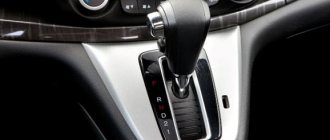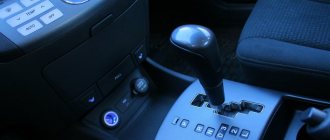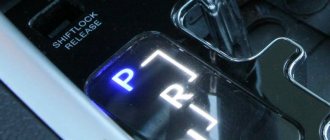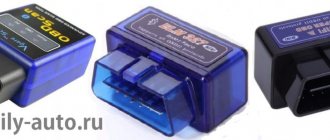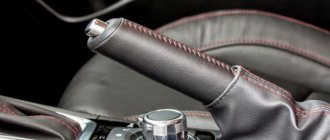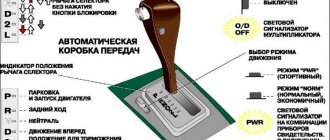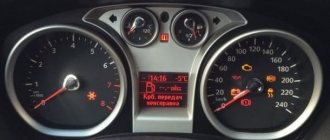Given the great popularity of hydromechanical automatic transmissions, manufacturers manufacture this type of transmission in such a way as to achieve maximum user convenience and versatility. At the same time, there is also the task of reducing fuel consumption.
As you know, the most common today is a simple four-speed automatic. As a rule, these gearboxes have several standard and understandable operating modes, which greatly simplifies operation.
However, on many automatic transmissions, in addition to the basic ones, you can also find additional modes. In this article we will talk about what overdrive is on an automatic transmission, how overdrive on an automatic transmission is turned on and off, why this mode is needed and when it is used.
Operating principle of "Overdrive"
This mode works after it is turned on as follows. If it is on, the box switches. Moreover, the first gear changes to second, then to third, and finally reaches fifth.
When the function is disabled, the block is placed on the fourth transmission level.
The vehicle in this case continues its movement at the third transmission level. At this time, the engine makes its maximum number of revolutions.
What is the shift lock release button?
Literally, the name is Shift Lock Release
can be translated as: removing the transmission block.
... In this case, the Shift Lock Release
. By clicking on it, you can safely switch the automatic transmission to neutral mode and move the car to the desired location.
Interesting materials:
How many days do you have to stay after surgery for appendicitis? How many days do they stay in intensive care after intestinal surgery? How many days to apply for chickenpox? How many days does it take to change Okvad? How many days can you use Levomekol ointment? How many days can you stay on the territory of Uzbekistan without registration? How many days can I file an appeal to the Unified State Examination? How many days can you gargle? How many travel days are given to a military personnel on leave? How many days should you apply it for chickenpox?
Purpose of the “Overdrive” function
If we consider one example, then understanding the functional purpose of “overdrive” will become much easier.
- If a vehicle is moving along a descent, and at the same time, the flow of vehicles is quite dense, then the speed can vary in this case from forty kilometers per hour to sixty with the O/D mode turned on. at the moment when the speed drops to forty, the gearbox does not switch to third speed from fourth.
- The flow rate begins to increase, but the revolutions have already dropped. It is required to accelerate, and it is quite difficult for the car to gain the necessary speed. At the same time, the box operates under a very heavy load, and this leads to an increased degree of wear.
- To switch to the third speed level, usually the gas pedal is sharply squeezed or the brake pedal is pressed, which creates inappropriate behavior of the car, along with an increase in shock loads on the gearbox.
When the O/D mode is turned off in this situation, the fourth transmission level is blocked. Vehicle movement is carried out exclusively on the third level.
At the same time, there are no shifts, and the car will move from forty kilometers per hour to sixty without any problems at a brisk pace and, vice versa, reduce the speed if the required speed is present.
Manu
Alternative names: Hold, ETC Snow, Snow, current gear lock switch. When pressed, the currently selected gear is blocked from downshifting or upshifting, and a warning lamp in the instrument cluster lights up.
The button can be used in conjunction with the “D” mode and a manually selected gear – values 1, 2, 3, L on the mode scale.
In the first case, the car will start from 2nd gear. This will avoid slipping on ice and snow. In the second case, it makes it easier to climb/overtake and allows you to effectively use engine braking on steep descents, preventing overheating of the brake system elements and saving their life.
Fuel consumption with overdrive
It may seem to many that the fuel consumption in the case considered increases significantly. After all, it is not a discovery for everyone that a long trip, subject to conditions
There is certainly a certain amount of truth in this statement.
- However, the fact that the presence of a low degree of revolutions, when movement occurs with a higher gear ratio, fuel consumption also does not decrease, but, on the contrary, increases.
- This occurs from a sharp drop in efficiency.
- This clearly shows that the difference in fuel consumption can be regarded as quite insignificant.
It is absolutely obvious that real savings occur in cases where the “overdriver” function is turned on and the car can move unhindered along the highway.
Why is there a button on the speed switch?
Why such buttons for fixing the automatic transmission lever are needed, everything is simple - this is done so as not to accidentally move the selector to an unnecessary position, for example, if you hit it with your hand or dropped something, and a child might pull it. And if you suddenly shift the lever into reverse gear at speed, then it’s not far from a breakdown.
Interesting materials:
What information is stored in the cloud? Which of the following rocks is igneous in origin? Which of Pushkin's fairy tales was the first to appear in print? What is James Cameron's goal for diving into the Mariana Trench? Which dwarf planet was the first to be discovered and was considered an asteroid? Which acid is stronger than sulfuric acid? What acidity should acid peat have? What command is needed for Private in Minecraft? Which company created CS GO? Which tape is better, emitter or slot tape?
How to enable overdrive mode
In order for the O/D mode to work, it must be turned on. For this purpose, there is a separate special button, which the developers have provided on the handle with switching of all modes of the automatic transmission.
- The “O/D off” indicator lights up, specifically signaling to the driver that the “overdrive” mode is disabled.
- If it is turned on, that inscription disappears automatically.
- During the transition to the fourth speed level, you can feel a medium-sized push, which will indicate that a higher gear level has been engaged.
- At the same time, there is a slight drop in speed.
You should not mistakenly assume that the presence of a characteristic push indicates that the fifth gear level has been switched on. In fact, this effect simply accompanies the blocking of the hydraulic transformer.
How does the automatic transmission work when 4th gear is engaged?
When you press the button, the automatic transmission torque converter is blocked. The driver feels a slight jolt. You should not associate the push with going into Overdrive. The latter occurs due to blocking of the gas turbine engine.
Read
How to properly brake the engine on an automatic transmission
If the car begins to brake, the “donut” is unlocked. After this, the downshift begins. The same thing happens when the speed decreases below 50 km/h.
How to use the mode
There are a great many situations on the roads, so there is no clarity in the explanations about the use of “overdrive”. In addition, each car has a different power level.
Long-term practice of experienced drivers allows them to use the mode according to the situation, but for beginners, experts recommend the following situations when it is better to disable this function:
- If there is a long descent ahead or, conversely, an ascent. If for many this option is very understandable during the ascent, then during the descent the need to switch off seems completely unnecessary. But the thing is that the turned on “overdrive” reduces the effect of braking, and this is not at all safe;
- If the car is in a dense stream of other vehicles, with the speed constantly changing in one direction or the other;
If overtaking on the road is carried out no higher than a speed of ninety kilometers per hour. This opinion seems quite controversial in many respects.
- If you increase the speed, then the maneuver will be completed faster. But taking your hand off the steering wheel just to press the desired button is quite imprudent, as it increases the likelihood of an unsafe situation for the driver and passengers.
- In this case, you can do the following. The gas pedal is pressed sharply all the way and the overdrive function is turned off. But such a need is justified only in cases where the driver feels his car well.
Otherwise, engine speeds can reach the “red zone”, and this increases the risk of wear resistance. This situation can only be resolved correctly by experience in driving this vehicle.
How does turning on O/D affect vehicle dynamics?
When overdrive is turned on, it stifles the dynamics of the car, trying to reduce fuel consumption and save the life of the engine and transmission. In normal operation - city, highway, dirt roads in villages, light off-road - the dynamics of the car are not particularly important. Moreover, budget cars are not bought to be driven.
Cars with automatic transmission generally accelerate worse; they are chosen for their comfort in traffic jams. Frequent owners of “Grant” with a machine gun are elderly people and girls. For those who like fast acceleration for the same price, it is better to take a closer look at used Japanese cars. They are faster, more reliable, and look better.
Overdrive
The automotive industry produces several types of automatic transmissions. These are robotic gearboxes, CVTs, preselective robots with two clutches, as well as hydromechanical automatic transmissions, which are the most common. They have 4 or 6 steps.
Such boxes usually have several selector positions, namely D, R, N and P. The first is “Drive”, which is used while driving, the others are “Reverse”, “Neutral” and “Parking”, which is activated when the car is parked . If you study the console in more detail, you will notice slots for manual mode with “-” and “+” signs, where you can forcefully change gears. However, on old boxes there is another button that is not very noticeable and is sometimes hardly used by the owners. This is an OD (Overdrive) function.
The OD button is usually located outside the selector and placed on the central tunnel, so it is little associated with the operation of an automatic transmission. It is small in size and sometimes marked with a snowflake, hinting that it is recommended to use the OD mode in winter, when the roads are covered with snow. This function allows the box not to go to the highest level and always operate at engine speeds in the range of 2-4 thousand, which makes it possible to always keep the engine at maximum torque. When OD mode is engaged, the 4-speed automatic transmission simply will not shift above 3rd gear. In slushy snow, extra Newton meters won't hurt. High revs also help to effectively brake the engine when releasing the gas.
Question answer
How to slip correctly on an automatic transmission?
The OD button is not always placed directly on the tunnel. Often it is placed on the gearbox lever in some inconspicuous place on the side or bottom of the selector. It is also possible that the automatic transmission does not have an overdrive program at all. On many modern cars it is replaced by a sport mode, which also maintains lower transmission levels for a long time.
